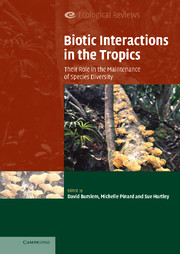Book contents
- Frontmatter
- Contents
- List of contributors
- Preface
- PART I Plant–plant interactions
- PART II Plant–microbe interactions
- PART III Plant–animal interactions
- 10 Implications of plant spatial distribution for pollination and seed production
- 11 Seed dispersal of woody plants in tropical forests: concepts, examples and future directions
- 12 The role of trophic interactions in community initiation, maintenance and degradation
- 13 Impacts of herbivores on tropical plant diversity
- 14 Have the impacts of insect herbivores on the growth of tropical tree seedlings been underestimated?
- 15 Multi-trophic interactions and biodiversity: beetles, ants, caterpillars and plants
- 16 The trophic structure of tropical ant–plant–herbivore interactions: community consequences and coevolutionary dynamics
- 17 Multitrophic interactions in a neotropical savanna: ant–hemipteran systems, associated insect herbivores and a host plant
- PART IV Biotic interactions in human-dominated landscapes
- Index
- References
10 - Implications of plant spatial distribution for pollination and seed production
Published online by Cambridge University Press: 25 August 2009
- Frontmatter
- Contents
- List of contributors
- Preface
- PART I Plant–plant interactions
- PART II Plant–microbe interactions
- PART III Plant–animal interactions
- 10 Implications of plant spatial distribution for pollination and seed production
- 11 Seed dispersal of woody plants in tropical forests: concepts, examples and future directions
- 12 The role of trophic interactions in community initiation, maintenance and degradation
- 13 Impacts of herbivores on tropical plant diversity
- 14 Have the impacts of insect herbivores on the growth of tropical tree seedlings been underestimated?
- 15 Multi-trophic interactions and biodiversity: beetles, ants, caterpillars and plants
- 16 The trophic structure of tropical ant–plant–herbivore interactions: community consequences and coevolutionary dynamics
- 17 Multitrophic interactions in a neotropical savanna: ant–hemipteran systems, associated insect herbivores and a host plant
- PART IV Biotic interactions in human-dominated landscapes
- Index
- References
Summary
Introduction
The production of offspring has long been thought to be predominantly limited by the availability of resources rather than mating opportunities, a view based on ‘Bateman's principle’ espoused by Bateman in 1948. Applied to vascular plants, this principle predicts that fruit production is limited by maternal resources rather than pollen transfer. However, in the past 20 years limitation of seed production by pollination has been reported in numerous studies, and reviews suggest that more than 50% of plants studied show increased fruit production following experimental pollen supplementation (Burd 1994). Of course, short-term pollen supplementation studies fail to capture the lifetime success of the whole plant, leading some critics to maintain that lifetime reproductive output remains resource-limited. Nevertheless, population-wide declines in reproductive success, at least in the short term, owing to reduced pollen availability or ineffectual pollination have now been recorded among a range of plant species and geographic locations.
The cause of the declining efficiency in pollination has often been traced to changes in the spatial distribution of plants in the population, which in turn has affected the abundance of pollinators or led to changes in their foraging behaviour. Plant spatial distribution has become increasingly relevant following rapid changes in land use and landscape structure driven by anthropogenic activities. Logging and land clearance for agriculture and development has caused degradation of forest habitats either through the partial removal of economically important species, or by wholesale clearance and effective fragmentation and isolation of remnant forest patches.
- Type
- Chapter
- Information
- Biotic Interactions in the TropicsTheir Role in the Maintenance of Species Diversity, pp. 241 - 266Publisher: Cambridge University PressPrint publication year: 2005
References
- 8
- Cited by



